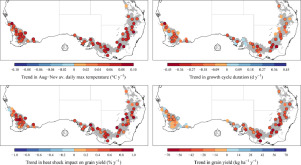当前位置:
X-MOL 学术
›
Agric. For. Meteorol.
›
论文详情
Our official English website, www.x-mol.net, welcomes your feedback! (Note: you will need to create a separate account there.)
Heat shocks increasingly impede grain filling but have little effect on grain setting across the Australian wheatbelt
Agricultural and Forest Meteorology ( IF 6.2 ) Pub Date : 2020-04-01 , DOI: 10.1016/j.agrformet.2019.107889 Behnam Ababaei , Karine Chenu
Agricultural and Forest Meteorology ( IF 6.2 ) Pub Date : 2020-04-01 , DOI: 10.1016/j.agrformet.2019.107889 Behnam Ababaei , Karine Chenu

|
Abstract While sustained warmer temperatures accelerate crop phenology, short exposures to supra-optimal temperatures (‘heat shocks’) can stress wheat crops, with drastic impact on grain yield and quality. Crop models are useful to evaluate crop response to heat at various spatial-temporal scales. A modified version of the Agricultural Production Systems sIMulator (APSIM) was used to investigate wheat response to increased average temperature and heat shocks for three cultivars of contrasting maturity sown from April to July across the Australian wheatbelt over 1985–2017. Increasing average temperatures have resulted in shortening the crop cycle by 1.6 days per decade since 1985, for standard management practices (i.e. mid-maturing cultivar Janz sown on 15 May). While the occurrence of warm nights (Tmin>17 °C) has not significantly changed in most tested conditions, daytime heat shocks occur significantly more often across the wheatbelt, with an extra 0.6 and 1.2 hot days (Tmax>26 °C) per decade occurring around anthesis and during early-mid grain filling, respectively. This warming has resulted in losses in grain number and individual grain weight rising by 1.0 and 4.0% per decade nationally, with an overall yield loss of 4.6% per decade. Heat events were found to have a greater effect on individual grain weight than grain number in Australia. Nationally, for Janz sown on 15 May, heat shocks have caused on average a 3.6% loss in grain number and an 18.1% loss in individual grain weight, resulting in a 20.8% yield loss. Considering the impact of other abiotic stresses like drought, simulated yield of Janz sown on 15 May has decreased by 242 kg ha−1 per decade on average, out of which 62 kg ha−1 was due to heat shocks. As temperatures are projected to keep rising with increased heat events, adapting wheat crops to warmer environments appears to be a priority to maintain or enhance yield.
中文翻译:

热冲击越来越阻碍谷物灌浆,但对澳大利亚小麦带的谷物结实影响不大
摘要 虽然持续升温会加速作物物候,但短期暴露于超适温度(“热冲击”)会对小麦作物造成压力,对粮食产量和质量产生巨大影响。作物模型可用于评估作物在各种时空尺度上对热的反应。农业生产系统模拟器 (APSIM) 的改进版本用于研究小麦对 1985-2017 年 4 月至 7 月在澳大利亚小麦带上播种的三个不同成熟品种的平均温度升高和热冲击的响应。对于标准管理实践(即 5 月 15 日播种的中熟品种 Janz),自 1985 年以来,平均气温升高导致作物周期每十年缩短 1.6 天。而暖夜的发生(Tmin> 17 °C) 在大多数测试条件下没有显着变化,整个小麦带的白天热冲击发生频率显着更高,每十年在开花前后和早中粒期间发生额外的 0.6 和 1.2 个热天 (Tmax>26 °C)分别填充。这种变暖导致全国粮食数量和单粒重的损失每十年增加 1.0% 和 4.0%,总产量每十年损失 4.6%。在澳大利亚,人们发现高温事件对单粒重的影响比对粒数的影响更大。在全国范围内,对于 5 月 15 日播种的 Janz,热冲击导致平均粒数损失 3.6%,单粒重损失 18.1%,导致单产损失 20.8%。考虑到干旱等其他非生物胁迫的影响,5 月 15 日播种的 Janz 的模拟产量平均每十年减少 242 kg ha-1,其中 62 kg ha-1 是由于热冲击。由于预计气温会随着高温事件的增加而不断上升,因此使小麦作物适应温暖的环境似乎是维持或提高产量的首要任务。
更新日期:2020-04-01
中文翻译:

热冲击越来越阻碍谷物灌浆,但对澳大利亚小麦带的谷物结实影响不大
摘要 虽然持续升温会加速作物物候,但短期暴露于超适温度(“热冲击”)会对小麦作物造成压力,对粮食产量和质量产生巨大影响。作物模型可用于评估作物在各种时空尺度上对热的反应。农业生产系统模拟器 (APSIM) 的改进版本用于研究小麦对 1985-2017 年 4 月至 7 月在澳大利亚小麦带上播种的三个不同成熟品种的平均温度升高和热冲击的响应。对于标准管理实践(即 5 月 15 日播种的中熟品种 Janz),自 1985 年以来,平均气温升高导致作物周期每十年缩短 1.6 天。而暖夜的发生(Tmin> 17 °C) 在大多数测试条件下没有显着变化,整个小麦带的白天热冲击发生频率显着更高,每十年在开花前后和早中粒期间发生额外的 0.6 和 1.2 个热天 (Tmax>26 °C)分别填充。这种变暖导致全国粮食数量和单粒重的损失每十年增加 1.0% 和 4.0%,总产量每十年损失 4.6%。在澳大利亚,人们发现高温事件对单粒重的影响比对粒数的影响更大。在全国范围内,对于 5 月 15 日播种的 Janz,热冲击导致平均粒数损失 3.6%,单粒重损失 18.1%,导致单产损失 20.8%。考虑到干旱等其他非生物胁迫的影响,5 月 15 日播种的 Janz 的模拟产量平均每十年减少 242 kg ha-1,其中 62 kg ha-1 是由于热冲击。由于预计气温会随着高温事件的增加而不断上升,因此使小麦作物适应温暖的环境似乎是维持或提高产量的首要任务。


























 京公网安备 11010802027423号
京公网安备 11010802027423号